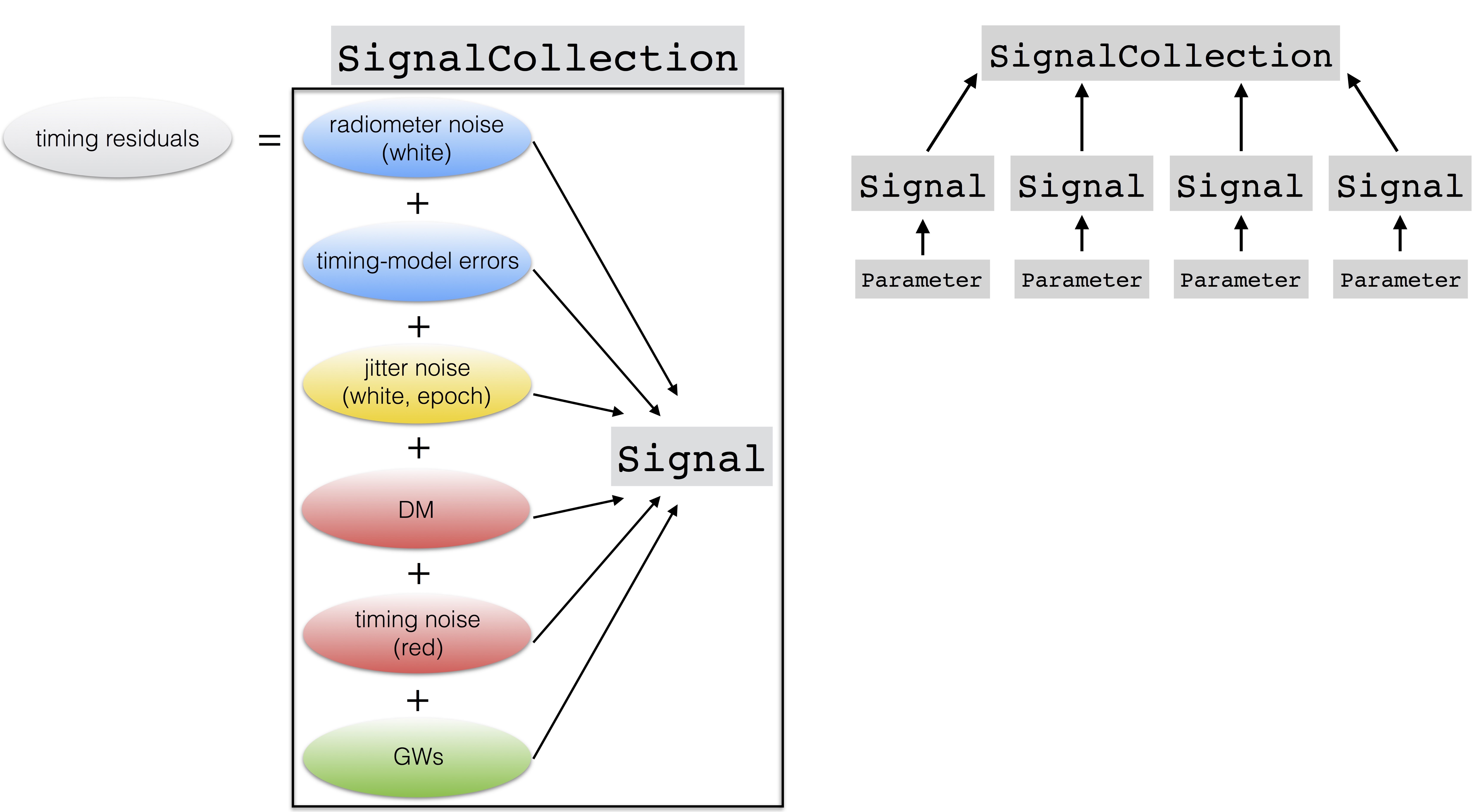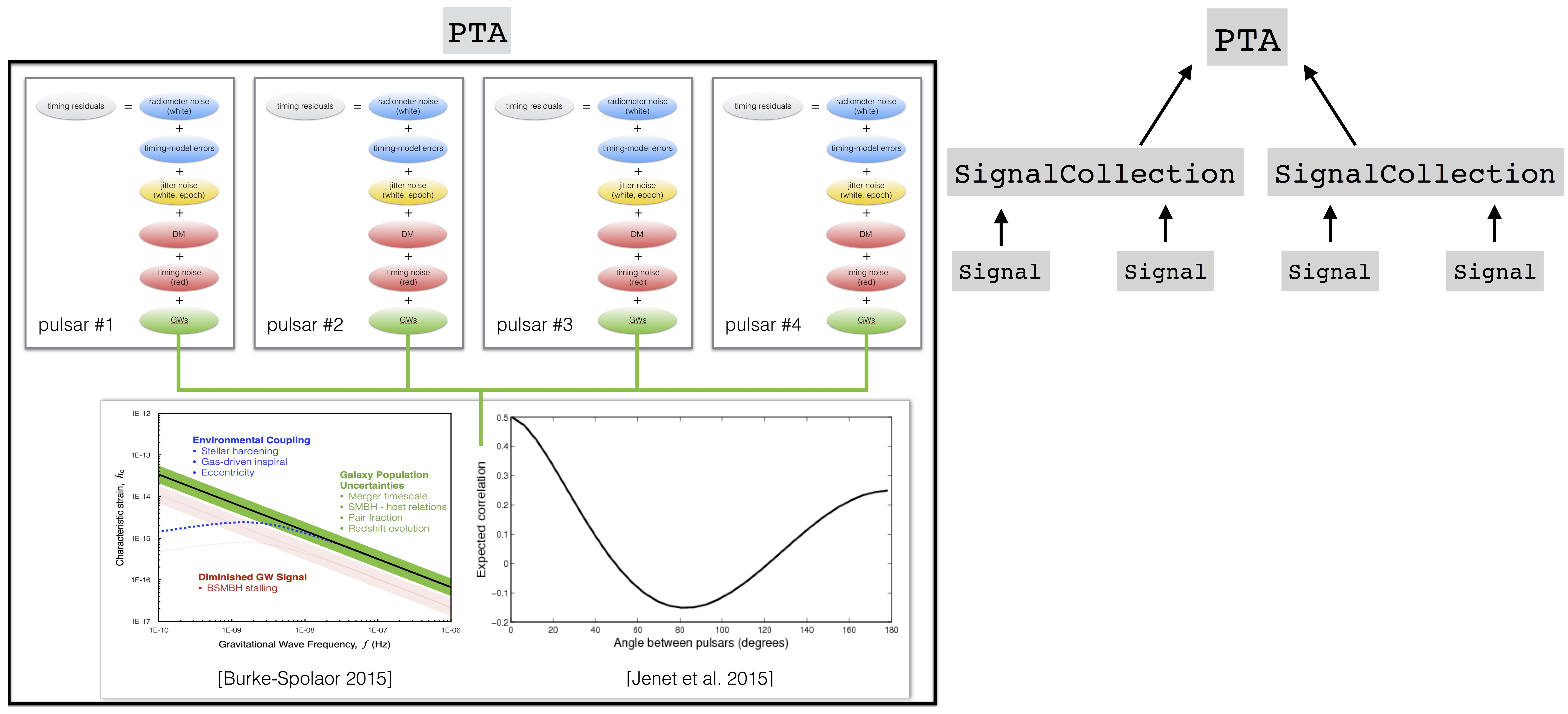Introducing enterprise¶

by: Justin Ellis$^{1,2}$, Michele Vallisneri$^2$, Paul Baker$^1$, Steve Taylor$^2$
$^1$ Center for Gravitational Waves and Cosmology, West Virginia University
$^2$ Jet Propulsion Laboratory, California Institute of Technology
Code website: https://github.com/nanograv/enterprise
Documentation: https://enterprise.readthedocs.io/
This Presentation¶
- Notebook can be found here https://github.com/jellis18/enterprise_tutorial_talk
- These slides are hosted here https://jellis18.github.io/enterprise_tutorial_talk
- You can follow along the notebook and run code on the NANOGrav notebook server under
shared/enterprise_tutorial
What is enterprise ?¶
enterpriseis an Enhanced Numerical Toolbox Enabling a Robust PulsaR Inference SuitE (complaints about this backronym are to be directed to Steve Taylor)
- Setting aside this backronym,
enterprisereally is a toolbox, not a set of black box functions and scripts!
- Extremely well tested (91% coverage!), well documented, and easy to use and to modify.
- Code development is done in a collaborative "fork and pull request" workflow.
- PRs must pass all unit tests including syntactic
pep8tests. - PRs must provide tests for new functionality (i.e. test coverage cannot drop).
- PRs must be reviewed by code maintainers.
- PRs must pass all unit tests including syntactic
Why do we need enterprise?¶
- Have you seen
PAL2/NX01/piccardcode?
- Need ability to add more complicated and customized signals to PTA models.
- Need better tested and better documented code base.
- Need more user friendly and intuitive API, along with simple channels for code development.
- Want
PINTcompatibility.
- We want
enterpriseto be the base for all of your future pulsar timing residual modeling needs.
enterprise code architecture¶

- The data (residuals) are modeled as the sum of
Signalcomponents which have their ownParameters. - The sum of all
Signalcomponents is aSignalCollection.
enterprise code architecture¶

- Each pulsar's model is a
SignalCollectionthat are combined to form aPTA. - Common
Signals are shared across pulsars Likelihoods act onPTAs.
Anatomy of an enterprise Signal¶
- $\delta\tau = \sum_{i} X(\phi_{\rm basis})_{(i)}w_{(i)} + s(\phi_{\rm det}) + n(\phi_{\rm white})$
- $w_{(i)} | K_{(i)} = \mathrm{Normal}(0, K(\phi_{\rm gp})_{(i)})$
class Signal(object):
"""Base class for Signal objects."""
def get_ndiag(self, params):
"""Returns the diagonal of the white noise vector `N`.
This method also supports block diagaonal sparse matrices.
"""
return None
def get_delay(self, params):
"""Returns the waveform of a deterministic signal."""
return 0
def get_basis(self, params=None):
"""Returns the basis array of shape N_toa x N_basis."""
return None
def get_phi(self, params):
"""Returns a diagonal or full rank covaraince matrix
of the basis amplitudes."""
return None
def get_phiinv(self, params):
"""Returns inverse of the covaraince of basis amplitudes."""
return None

Standard Noise Analysis¶
- Set up Parameters
In [191]:
# define white noise parameters
efac = parameter.Uniform(0.1, 10)
log10_equad = parameter.Uniform(-10, -5)
log10_ecorr = parameter.Uniform(-10, -5)
# red noise parameters
log10_A = parameter.Uniform(-20, -11)
gamma = parameter.Uniform(0, 7)
- Construct Signal and initialize PTA (of one)
In [192]:
# define selection by observing backend
selection = selections.Selection(selections.by_backend)
# define white noise signals (selection tells it to split based on backend)
ef = white_signals.MeasurementNoise(efac=efac, selection=selection)
eq = white_signals.EquadNoise(log10_equad=log10_equad, selection=selection)
ec = white_signals.EcorrKernelNoise(log10_ecorr=log10_ecorr,
selection=selection)
# define powerlaw PSD and red noise signal
pl = utils.powerlaw(log10_A=log10_A, gamma=gamma)
rn = gp_signals.FourierBasisGP(pl, components=30)
# linear timing model
tm = gp_signals.TimingModel()
# total signal (this is some high tech shit right here!)
s = ef + eq + ec + tm + rn
# setup PTA
pta = signal_base.PTA([s(psr)])
- Check parameterization with:
In [193]:
print pta.params
["B1855+09_430_ASP_efac":Uniform(0.1,10), "B1855+09_430_ASP_log10_ecorr":Uniform(-10,-5), "B1855+09_430_ASP_log10_equad":Uniform(-10,-5), "B1855+09_430_PUPPI_efac":Uniform(0.1,10), "B1855+09_430_PUPPI_log10_ecorr":Uniform(-10,-5), "B1855+09_430_PUPPI_log10_equad":Uniform(-10,-5), "B1855+09_L-wide_ASP_efac":Uniform(0.1,10), "B1855+09_L-wide_ASP_log10_ecorr":Uniform(-10,-5), "B1855+09_L-wide_ASP_log10_equad":Uniform(-10,-5), "B1855+09_L-wide_PUPPI_efac":Uniform(0.1,10), "B1855+09_L-wide_PUPPI_log10_ecorr":Uniform(-10,-5), "B1855+09_L-wide_PUPPI_log10_equad":Uniform(-10,-5), "B1855+09_gamma":Uniform(0,7), "B1855+09_log10_A":Uniform(-20,-11)]
- Access to likelihood and prior function with:
In [194]:
# random parameters for testing
xs = {p.name: p.sample() for p in pta.params}
# likelihood
print pta.get_lnlikelihood(xs)
# prior
print pta.get_lnprior(xs)
43167.2424803 -26.1887770544
- These likelihood and prior functions can then be fed to the sampler of your choice!
11-year Stochastic GWB upper limit with ephemeris modeling¶
- Setup Parameters
In [208]:
# white noise parameters
# set them to constant here and we will input the noise values
# after the model is initialized
efac = parameter.Constant()
equad = parameter.Constant()
ecorr = parameter.Constant()
# red noise parameters
# LinearExp prior places uniform prior on A while sampling in log10_A
log10_A = parameter.LinearExp(-20, -11)
gamma = parameter.Uniform(0, 7)
# common red noise
# naming signals here tells enterprise that these parameters
# are shared across pulsars
log10_Agw = parameter.LinearExp(-18, -11)('log10_Agw')
gamma_gw = parameter.Constant(4.33)('gamma_gw')
- Set up Signals
In [ ]:
# define selection by observing backend
selection = selections.Selection(selections.by_backend)
# define white noise signals
ef = white_signals.MeasurementNoise(efac=efac, selection=selection)
eq = white_signals.EquadNoise(log10_equad=equad, selection=selection)
ec = white_signals.EcorrKernelNoise(log10_ecorr=ecorr, selection=selection)
# get overall time span
tmin = np.min([p.toas.min() for p in psrs])
tmax = np.min([p.toas.max() for p in psrs])
Tspan = tmax - tmin
# define powerlaw PSD and red noise signal
pl = utils.powerlaw(log10_A=log10_A, gamma=gamma)
rn = gp_signals.FourierBasisGP(pl, components=30, Tspan=Tspan)
# GWB
cpl = utils.powerlaw(log10_A=log10_Agw, gamma=gamma_gw)
orf = utils.hd_orf()
crn = gp_signals.FourierBasisCommonGP(cpl, orf, components=30, Tspan=Tspan)
# linear timing model
tm = gp_signals.TimingModel()
## Physical ephemeris model
eph = deterministic_signals.PhysicalEphemerisSignal(use_epoch_toas=True)
- Create total signal and intialize PTA
In [ ]:
# total signal
s = ef + eq + ec + rn + crn + tm + eph
# setup PTA
pta = signal_base.PTA([s(p) for p in psrs])
# set fixed white noise parameters
pta.set_default_params(setpars)
That's great and all, but what if I want to make a new signal?¶
- There are 3 types of built in generic signals for different signal types
gp_signals.BasisGPfor Gaussian Process signals that have a set of basis functions and a kernel.white_signals.WhiteNoisefor white noise signals with a specific variance.deterministic_signals.Deterministicfor determinisic signals that return a delay waveform.
Generic Gaussian Process Signal¶
- Suppose we want to do Ridge regression on the linear timing model (Gaussian prior on coefficient)
In [45]:
@signal_base.function
def scaled_tm_basis(Mmat):
"""Returns mean and variance scaled timing model
design matrix and weights to be used in prior
function."""
mn = Mmat.mean(axis=0)
sd = Mmat.std(axis=0)
ret = Mmat.copy()
ret[:, 1:] -= mn[1:]
ret[:, 1:] /= sd[None, 1:]
return ret, np.ones_like(mn)
@signal_base.function
def ridge_prior(weights, log10_variance=-14):
"""Return gaussian prior with variance parameter."""
return weights * 10**(log10_variance)
- Basis function must return an
ntoaxnbasisarray and annbasisvector of weights. - Prior function must return either an
nbasisarray (diagonal of covariance matrix) or the fullnbasisxnbasiscovariance matrix.
- Can be added to model via:
In [59]:
log10_variance = parameter.Uniform(-20, -10)
basis = scaled_tm_basis()
prior = ridge_prior(log10_variance=log10_variance)
ridge = gp_signals.BasisGP(prior, basis, name='ridge')
Generic White Noise Signal¶
- Suppose we want to add a DMEQUAD signal:
In [48]:
# define DM EQUAD variance function
@signal_base.function
def dmequad_ndiag(freqs, log10_dmequad=-8):
"""Reads in radio frequencies and DMEQUAD value and outputs variance."""
return np.ones_like(freqs) * (1400/freqs)**4 * 10**(2*log10_dmequad)
- Variance function must return the variance in seconds$^{2}$.
- Because this is an
enterpriseFunctionit readsfreqsdirectly from thePulsarobject.
- can be added to signal via:
In [52]:
log10_dmequad = parameter.Uniform(-10, -5)
dmvariance = dmequad_ndiag(log10_dmequad=log10_equad)
dmeq = white_signals.WhiteNoise(dmvariance)
Generic Deterministic Signal¶
- Suppose we want to add a wavelet signal.
In [72]:
@signal_base.function
def wavelet(toas, log10_A=-7, log10_Q=2, t0=55000, log10_f0=-7.5, phi0=0):
# convert units
A = 10**log10_A
Q = 10**log10_Q * const.day
t0 *= const.day
f0 = 10**log10_f0
wv = A * np.cos(2*np.pi*f0*(toas-t0)+phi0) * np.exp(-(toas-t0)**2/2/Q**2)
return wv
- Waveform function must return delay waveform in seconds
- Can be added to signal via:
In [78]:
log10_A = parameter.Uniform(-10, -5)
log10_Q = parameter.Uniform(0, 3)
t0 = parameter.Uniform(53000, 58000)
log10_f0 = parameter.Uniform(-9, -6)
phi0 = parameter.Uniform(0, 2*np.pi)
wf = wavelet(log10_A=log10_A, log10_Q=log10_Q, t0=t0,
log10_f0=log10_f0, phi0=phi0)
wvlt = deterministic_signals.Deterministic(wf)
Custom Signals¶
- It may be the case that your signal doesn't fit nicely into the above categories
- Maybe you need to do a lot of work to set up the signal (reading in auxiliary files, interpolations, etc.)
- In that case you may have to do a bit more work, but not too much :)
- You can subclass one of the existing generic signal types and modify the methods or you can subclass the base
Signalclass if your signal is very different.
Fourier Basis example¶
- This
FourierBasisGPclass is actually part ofenterprisebut it works for an example of how to sublcass an existingSignal. - Remember we use Class Factories not just classes. See the documentation on this for more details.
In [91]:
def FourierBasisGP(spectrum, components=20,
selection=selections.Selection(selections.no_selection),
Tspan=None):
"""Convenience function to return a BasisGP class with a
fourier basis."""
# use fourier basis and use BasisGP
basis = utils.createfourierdesignmatrix_red(nmodes=components, Tspan=Tspan)
BaseClass = BasisGP(spectrum, basis, selection=selection)
class FourierBasisGP(BaseClass):
signal_type = 'basis'
signal_name = 'red noise'
return FourierBasisGP
- In this example we simply define the Fourier Basis inside of the factory and don't overwrite any methods.
Subclassing Deterministic example¶
- Say we want to use the wavelet signal defined above, but we don't want to have to evaluate it for all of the per-channel TOAs
- We would rather use the epochs to evaluate the waveform and then interpolate back on to the TOAs in the end
- We can do that as follows
In [177]:
def WaveletSignal(log10_A, log10_Q, t0, log10_f0, phi0, use_epoch_toas=True):
"""Wavelet signal with option to use epoch TOAs"""
# setup wavelet signal and use Deterministic
wf = wavelet(log10_A=log10_A, log10_Q=log10_Q, t0=t0,
log10_f0=log10_f0, phi0=phi0)
BaseClass = deterministic_signals.Deterministic(wf, name='wavelet')
class WaveletSignal(BaseClass):
def __init__(self, psr):
super(WaveletSignal, self).__init__(psr)
if use_epoch_toas:
# get quantization matrix and calculate daily average TOAs
U, _ = utils.create_quantization_matrix(psr.toas, nmin=1)
self.uinds = utils.quant2ind(U)
avetoas = np.array([psr.toas[sc].mean() for sc in self.uinds])
# replace kwarg in waveform with avetoas instead of toas
self._wf[''].add_kwarg(toas=avetoas)
@signal_base.cache_call('delay_params')
def get_delay(self, params):
delay = self._wf[''](params=params)
if use_epoch_toas:
for slc, val in zip(self.uinds, delay):
self._delay[slc] = val
return self._delay
else:
return delay
return WaveletSignal
- This is a bit advanced but gives you an idea of how you can make completely custom signals.
Non-stationary Signals via Selections¶
- You might have noticed the
selectionarguments above. - This allows us to split up the signal into different segments (per backend for example) via a user defined
Selectionfunction - All base
BasisGP,WhiteNoise, andDeterministicSignalssupport selection. - Say we want to model the first half of the data independently from the rest for a certain signal, we can define the following:
In [178]:
def cut_half(toas):
"""Selection function to split by data segment"""
midpoint = (toas.max() + toas.min()) / 2
return dict(zip(['t1', 't2'], [toas <= midpoint, toas > midpoint]))
- Use
selection=selections.Selection(cut_half)as a keyword argument in the signal and thats it!